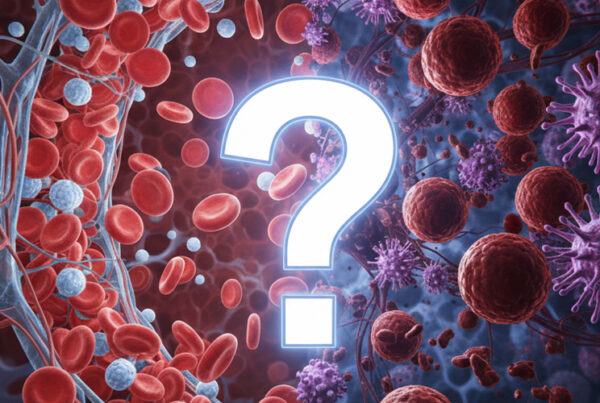
Introduction
Idiopathic Myelofibrosis (MF) is a rare condition associated with bone marrow. Annually, it affects around 1 in 100,000 people. The most obvious symptoms of myelofibrosis start with a scar formation in bone marrow ultimately leading to anemia disease, spleen, and liver enlargement, extreme fatigue, etc.
There’s no cure for this condition, however, there is a possible treatment for myelofibrosis available. Let’s dig deeper into the facts like what is idiopathic myelofibrosis, its symptoms, types, chronic idiopathic myelofibrosis, and more.
What is Idiopathic Myelofibrosis? Chronic Idiopathic Myelofibrosis
The disorder primarily affects older adults, typically appearing after the age of 50. While there are similarities between chronic idiopathic myelofibrosis and other types of myeloproliferative disorders, the scarring in the bone marrow is the main feature that helps to identify this condition.
An uncommon kind of blood cancer called idiopathic myelofibrosis causes fibrous scar tissue to replace the delicate, spongy bone marrow inside of your bones. It is a myeloproliferative condition and a type of chronic leukemia. Chronic Myeloproliferative diseases are characterized by an excess of red blood cells produced in the bone marrow.
Your bone marrow generates stem cells, which are immature blood-forming cells that can differentiate into platelets, white blood cells, or red blood cells. A mutation in a stem cell’s DNA results in myelofibrosis, a condition where the cell becomes malignant or dysfunctional. As the cell divides, the mutation is transferred to new cells.
Idiopathic myelofibrosis is often referred to as primary myelofibrosis when it develops on its own without an underlying cause. However, it can also develop secondary to other conditions, leading to a key distinction between primary vs idiopathic myelofibrosis.
Primary vs Idiopathic Myelofibrosis
Primary vs. Idiopathic Myelofibrosis refers to two closely related terms often used interchangeably, but they have slight distinctions. Primary Myelofibrosis occurs as an isolated condition without any preceding blood disorders, which is why it’s commonly referred to as Idiopathic Myelofibrosis, “idiopathic” meaning the cause is unknown.
In contrast, secondary myelofibrosis develops as a complication of other myeloproliferative disorders, such as polycythemia vera or essential thrombocythemia. Both primary and idiopathic forms lead to bone marrow fibrosis, but the distinction lies in their origin. Primary cases arise spontaneously, while secondary forms are linked to pre-existing conditions. Understanding primary vs. idiopathic myelofibrosis helps in tailoring treatment strategies and recognizing the underlying pathways involved.
Types of Myelofibrosis
Two types of myelofibrosis are there:
- Myelofibrosis that develops on its own is known as primary myelofibrosis.
- Other blood illnesses such as polycythemia vera or primary thrombocytosis can cause secondary myelofibrosis. Ten to twenty percent of cases are related to secondary myelofibrosis.
Understanding the difference between primary vs idiopathic myelofibrosis is important for determining the best course of treatment. In both cases, the scarring of the bone marrow leads to similar symptoms and complications, though the underlying causes may differ.
Causes and Risk Factors
Talking about the causes, as the term idiopathic implies, the causes are unknown. However, certain genetic mutations are known to be the background reason for the disease’s onset.
These mutations, particularly in the JAK2, CALR, and MPL genes, cause the bone marrow to produce blood cells abnormally. These genetic mutations do not guarantee the development of idiopathic myelofibrosis, but they are a significant risk factor. Additionally, exposure to certain toxins or radiation has been suggested as a contributing factor in some cases, though these are fewer common causes.
Risk factors for developing chronic idiopathic myelofibrosis include advanced age, a history of other blood disorders, and certain genetic predispositions. For example, individuals with a family history of myeloproliferative disorders may be more prone to developing the disease. However, as the term “idiopathic” implies, the exact cause often remains unclear in most cases.
Symptoms of Myelofibrosis
The symptoms of myelofibrosis can vary greatly depending on the stage of the disease and the individual patient. Early in the disease, symptoms may be mild or non-existent, leading to a delayed diagnosis. As the condition progresses, more noticeable symptoms begin to develop, including:
- Fatigue and weakness
- Shortness of breath, particularly during exertion
- Easy bruising and bleeding
- Anemia (low red blood cell count)
- Splenomegaly (enlarged spleen), which can cause pain or a feeling of fullness in the abdomen
- Bone pain or discomfort
- Weight loss and night sweats
One of the most common symptoms of myelofibrosis is anemia, which occurs because the bone marrow is unable to produce enough red blood cells. Additionally, the enlargement of the spleen (splenomegaly) occurs because the body tries to compensate for the bone marrow’s lack of functioning by producing blood cells elsewhere, such as in the spleen. This can lead to major discomfort and even further health complications.
Also read: What is Oncology Research? An Introduction to the Study of Cancer.
Diagnosis of Idiopathic Myelofibrosis
Diagnosing idiopathic myelofibrosis takes a complete approach, from physical examinations, and blood tests, to bone marrow biopsies.
A physical exam may reveal an enlarged spleen, which is often one of the early signs of chronic idiopathic myelofibrosis. Blood tests typically show abnormalities in red and white blood cell counts and platelet levels. A main identification sign of idiopathic myelofibrosis is the presence of “tear-drop” shaped red blood cells on a blood smear.
The most reliable diagnosis is usually made through a bone marrow biopsy. It shows the extent of fibrosis (scarring) within the bone marrow. Genetic testing can also reveal mutations in the JAK2, CALR, or MPL genes, helping to confirm the diagnosis and distinguish primary vs idiopathic myelofibrosis.
Possible Treatment for Myelofibrosis
There’s no cure for idiopathic myelofibrosis. However, a potential treatment for myelofibrosis helps manage the condition and slow down the progress of the disease. The treatment plan for a patient depends on their age, overall health, and the severity of the disease.
Medications
JAK inhibitors, such as Ruxolitinib, are commonly used to reduce spleen size and alleviate symptoms like fatigue and anemia. Other medications may include growth factor injections to boost red blood cell production and chemotherapy to reduce overactive blood cell production.
Blood transfusions
For patients with severe anemia, regular blood transfusions can help manage the lack of red blood cells and alleviate related symptoms.
Stem cell transplantation
In some cases, a stem cell transplant may offer a curative option, especially for younger, healthier patients. This treatment involves replacing the diseased bone marrow with healthy donor cells, though it carries significant risks and is only appropriate for a subset of patients.
Supportive treatments
In addition to medications, supportive treatments like spleen removal (splenectomy) or radiation therapy may be used to relieve spleen-related symptoms.
The choice of treatment is highly personalized, with a focus on symptom management and improving the patient’s quality of life. Although there’s no cure but Myelofibrosis clinical trials are being conducted to help find a potent therapy and contribute to decreasing the occurrence of this disease.
Conclusion
To conclude, idiopathic myelofibrosis is a complex chronic bone marrow disorder affecting blood production and ultimately the quality of life. Its cause is unknown and there’s no cure for it. However, medications and alternatives can help manage the situation. Additionally, clinical trials are being conducted to help find a better therapeutic option. So, enroll in the clinical trials in Nebraska today and help NHO Revive, the leading contractual clinical research organization for cancer research in finding a treatment option for this ailment.







